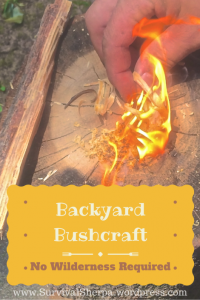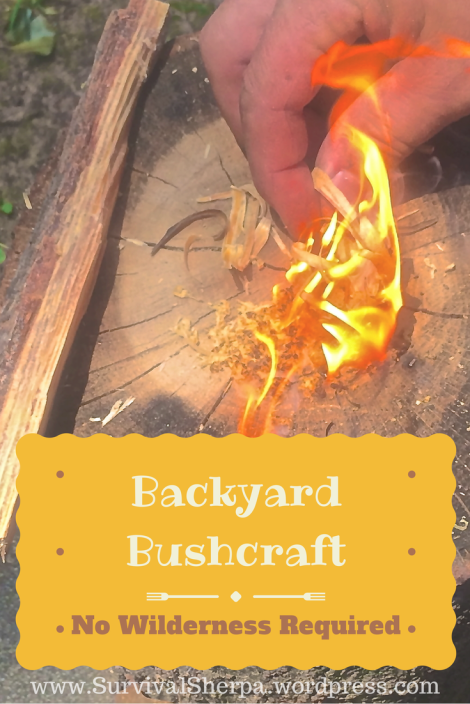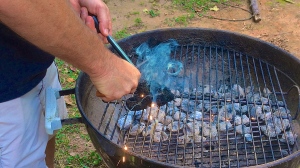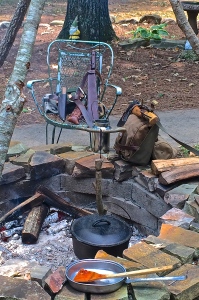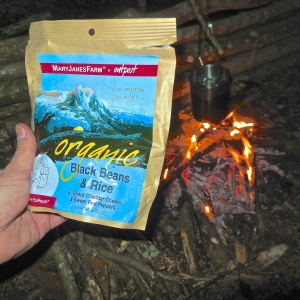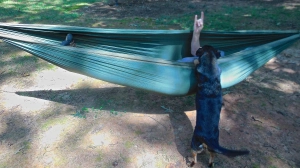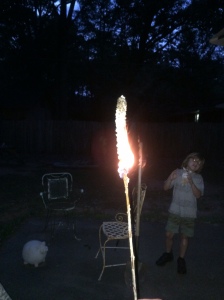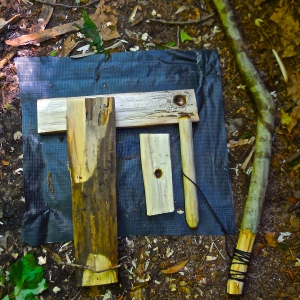Doing the Stuff of self-reliance takes time, resources, tools, and want to. More important than any of these is ACTION! With only 24 hours in a day, you can’t always trek to your personal space in the woods to practice wilderness survival skills. Hectic schedules and time constants eat away at your availability.
You’re family needs quality time… and no, staring at the TV or computer screen doesn’t count. No better way to hang out with your loved ones, even the indoors lover, than to introduce them to outdoor self-reliance skills in a controlled setting. Your adventures await one step over your door sill – no wilderness required!
Convenience just destroyed all the excuses.
Our Self-Reliant Summer series [2] is intended to keep us motivated with common sense ideas for Doing the Stuff. Stay with us to learn how to strike self-reliance gold in your backyard.
Bloom Where You’re Planted
It would be great if we all had a picturesque wilderness for a backyard. That’s not likely. Driving hours to reach one is not practical for busy people. The solution is to bloom where you’re planted [3].
Fire Pits and BBQ Grills!
Making fire is a critical skill many of us take for granted. In ideal conditions, fire may be easy. Just flick your Bic and, poof, you have flames. It’s wise to practice several ways to achieve a sustainable fire.
A BBQ grill is a good tool for practicing fire making!
Fire is simple. All that’s needed is…
- Air
- Heat
- Fuel
These elements make up the fire triangle. Take away any one of these and you no longer have fire. Starve the fire of air and you’re making charred material for your next fire.
You can practice your fire making skills with the available resources out back. No wood? No problem. Dirt Road Girl and I are known to walk our neighborhood, wagon in tow, collecting dead wood conveniently stacked at the edge of neighbor’s yards. We get our walk in and employ our possum mentality [5] for free resources.
Fire Project 1: Make char cloth [6] and charred material [7].
Fire Project 2: Practice making fire using 3 different methods: friction(bow drill [8], hand drill, fire plow), heat (fresnel lens, lighter, matches, etc.), and sparks (ferro rod, flint and steel). You’ll need your homemade char material for the flint and steel.
Fire Project 3: Make a fire from one stick only [10].
If you’re neighborhood allows open fires in a fire pit, consider building or buying one. If not, practice inside a charcoal or gas grill. If grills aren’t allowed, call the moving van! Build fires directly on the grill grate or use a board or other flat object as a support.
Be curious. Try new tinder materials. I discovered an excellent coal extender growing on beech trees [11] near my shelter. [That’s me – two photos up – at the Weber grill lighting dry sooty mold from a Beech tree with a ferro rod]
What’s for Dinner?
After building a fire, why not use it to practice cooking over an open flame. Since you’re in the backyard and conveyance is not an issue, break out that cast iron dutch oven granny passed down to you. Once your fire burns down a bit, suspend the pot over a bed of coals with a bushcraft tripod. Experiment with cooking methods other than stabbing a tube steak on the end of a stick.
Practice using twig stoves like the Emberlit [13]. A handful of twigs can boil water for a pre-packaged meal in a stainless steel camp cup.
Tied in Knots
Do you remember how to tie that nifty knot you saw on YouTube? Probably not. Find two trees in the yard and practice tying out your tarp and hammock. Repetition is the mother of all learning.
Basic knots should become second-hand. You won’t need to know 41 knots to survive and thrive in a survival scenario. Knowing a few simple knots will save you time and cordage. The knots I use most while bushcrafting are the timber hitch, trucker’s hitch, Siberian hitch, bowline, clove hitch, and tension hitch. Learn knots with a specific purpose and tie them repeatedly until you’re able to do so even in the dark.
Sharp Skills
The cutting tool is fundamental for bushcraft. Safe use of knives, saws, and axes should be learned before heading to the big boy woods. The backyard is the perfect classroom.
Wielding sharp tools has risks. You never really know your cutting tool personally until it bites you. Accidents happen to even the most skilled bushcrafter. Practicing in a controlled setting like your backyard builds confidence and skills for times when your life may one day depend upon sharp stuff. Plus, first aid is close by.
Sharp Skill 1: Make a feather stick for your backyard fire. Bracing your knife against your knee with the cutting edge facing away from your body, pull a piece of wood towards your body to curl shavings on the stick. You can also place the stick on another wooden surface (anvil) and slice curls using the full length of the blade.
Sharp Skill 2: Baton wood with your knife. This skill is useful when a camp ax is not available. This method can produce pencil lead size, pencil size, thumb size, and larger fuel from logs. I prefer batoning for the one stick challenge and when creating bow drill sets. More precision in woodcraft can be achieved by practicing your preferred method.
Sharp Skill 3: Notches add stability when joining and lashing woodcraft items. They’re also essential for the hearth board on your bow drill fire set.
Got Cover?
There may not be enough resources to build a debris hut out by the kids swing set, but you can practice tarp and tent set up.
Common man/woman cover can be an affordable tarp or poncho. Start with the resources you have. Practice different cover configurations [21] to find out what works for different situations.
Sticks and Strings (Archery)
Archery has been given a huge boost by the recent Hunger Games books and movies. Capitalize on the interest with your children or grandchildren.
Archery has been practiced for thousands of years by hunter-gatherers, indigenous groups, and self-reliant folk. This tool can be used for harvesting game quietly and an effective addition to your SHTF arsenal. Zombies beware! The place to hone this skill is in the backyard. Once hooked on stick and string, you and your entire family can enjoy this as a family sport and survival skill.
Make Your Own Stuff
Simple machines [23] in bushcraft can be used to build stuff to aid in self-reliance and survivability. Here are three projects that are doable in the backyard.
Project 1: Build a simple cooking tripod [24] for your backyard kitchen.
Project 2: Torches. Gotta have torches. Kid’s love them and they’re fun to build!
- How to make a fatwood torch [25]
- Miner’s torch (pictured below) made of a dried mullein stalk and soy wax (pine sap or tallow can also be used) – Warning: burning close the base of the seed head will burn through the stalk quickly
Mullein torch
Project 3: Make a bow drill set from one piece of poplar or other suitable wood
Eat the Yard
Every backyard lawn has weeds. Learning to safely identify wild edibles for nutrition and medicine is smart. Like every other skill mentioned above, wildcrafting can be done close to home. We place value on what we name. Before I knew the name of Mullein, it was just a weed growing along the fence row of our pasture. Now it’s a valued item in our herbal medicine kit.
There are many resources available to help you identify wild edibles. One that I’ve found most helpful is The Forager’s Harvest [28] by Samuel Thayer. Thayer didn’t just regurgitate what other authors wrote about, he spent years of actually Doing the Stuff in the field of wild edibles.
You can check out our Foraging Feral Food [29] page and Herbal Medicine Kit [30] series if you’d like to dig deeper into wildcrafting.
Doing the Stuff of self-reliance through bushcraft should start in your backyard. 17th and 18th century woodsmen forged their skills close to home. Owning these essential skills was necessary to survive the wilderness treks with minimal gear. That’s the essence of bushcraft – dependence on skills more so than the latest shiny object and technological gadget.
What happens when technology fails? Hopefully your skills will get you through. Your journey to self-reliance starts in your own backyard!
Keep Doing the Stuff,
Todd
